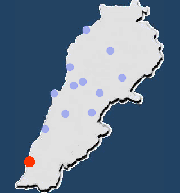|
 Home
> Touristic Sites
> Tyre Home
> Touristic Sites
> Tyre
Introduction | Aanjar |
Baalbeck |
Beirut |
Beiteddine |
Byblos |
The Cedars |
Faqra |
Jeita |
Sidon |
Tripoli | Tyre |
Zahle
|
Although the earliest origins of
Tyre are unknown, the testimonies of ancient historians and some
archaeological evidence suggest that it goes back to the start of the 3rd
millennium BC. Tyre was originally a rocky Island, then in the 10th
century BC, King Hiram expanded the mainland and built two ports and a temple
to Melkart, the city's god. From the earliest times, Tyre fascinated to it the
envy of the people of the Old World due to Its flourishing maritime trade,
Mediterranean colonies and its purple dye and glass industries made. In the 6th
century BC, the Tyrians successfully defied Bebuchadnezzar for 13 years.
Alexander The Great laid siege to it for 7 years, finally overwhelming the
island city by constructing a great causeway from the shore to the island. In
their day, the Romans built a magnificent city at Tyre. The remains of
its Roman streets, arcades and public buildings, including one of the largest
hippodromes of the period, are Tyre's major attractions. Occupied by the Muslim
Arabs in 636, then captured in 1124 by the Crusaders, Tyre was an important
fortified town of the kingdom of Jerusalem. In 1291 the Mamlukes took
the city, then during the 400 year Ottoman period beginning in 1516 it remained
a quiet town. |

|
It has expanded its industries particularly its
famous purple-dye and glass making. At this time, the purple-dye
was extracted from the murex. Many civilizations have passed by: Arab,
Byzantine, Roman, Greek and Phoenician.
Like other cities of Lebanon, Tyre is therefore
home to many archaeological sites. The importance of this historical city and
its monuments was highlighted in 1979 when UNESCO declared it a World
Heritage Site. Of interest, are the reconstructed Arch of Triumph, Roman
Baths, The Necropolis and Sarcophagi, and the Hippodrome which is one of the
largest in the world, it extends about 500m in length and 160m in width.
Nowadays, Tyre is also considered one of the biggest sites of the Middle
East.
 Discover these Travel Guides on Lebanon recommended by LebGuide.com on Amazon... Discover these Travel Guides on Lebanon recommended by LebGuide.com on Amazon...
Discover the complete selection of recommended books by LebGuide 
Introduction | Aanjar |
Baalbeck |
Beirut |
Beiteddine |
Byblos |
The Cedars |
Faqra |
Jeita |
Sidon |
Tripoli | Tyre |
Zahle
|









